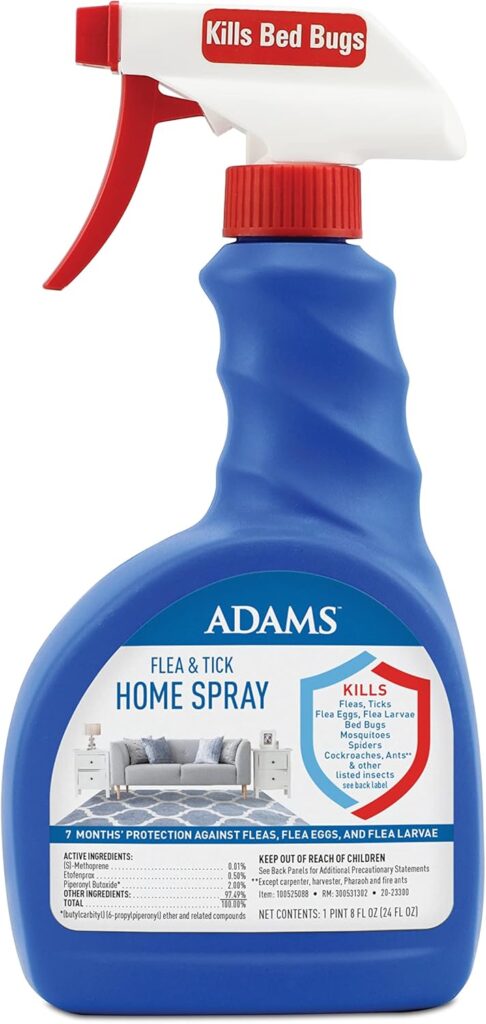Fleas on kittens can be a distressing sight. Not only do these pests cause discomfort and potential health issues for your furry friend, but they can also infest your home if not dealt with promptly. Here’s what you can do to help your kitten:

How to Get Rid of Fleas on Kittens: A Complete Guide
Finding fleas on your kitten can be concerning, especially since young kittens are so delicate. Fleas are unfortunately quite common, and many kittens are exposed to them early in life. While it might seem normal for kittens to have fleas, it’s important to treat them as soon as possible to avoid health issues like anemia or skin infections.
One of the safest ways to start treating fleas on your kitten is by using a flea comb to gently remove the fleas from their fur. For kittens too young for flea treatments, this is a safe, chemical-free option. Be sure to wash your kitten’s bedding and treat your home as well. Products like Adams Flea & Tick Home Spray are great for killing fleas and flea eggs in your home, preventing re-infestation.
To learn more about effective flea control methods, check out this how-to guide on winning the battle against fleas and ticks for a comprehensive approach to keeping your kitten flea-free.

Is It Normal for Kittens to Have Fleas?
While it’s unfortunately common for kittens to come into contact with fleas, it’s not something to overlook. Fleas can cause discomfort and lead to more serious health problems if left untreated, including skin infections, anemia, and even tapeworms. Kittens can pick up fleas from their environment, other animals, or even their mother if she had fleas when they were born.
Fleas can multiply quickly, so even if you spot just a few, it’s crucial to act fast. It’s normal for kittens to have fleas, but it’s not healthy to let them go untreated. Early intervention is key to keeping your kitten safe and comfortable. Be sure to also treat the surrounding environment with a product like Adams Flea & Tick Home Spray to kill fleas in your home, as these pests can hide in carpets, bedding, and furniture.
For more tips on treating fleas and keeping your pet’s coat healthy, take a look at these grooming tips to maintain their well-being.

How to Treat Fleas on Kittens
When it comes to treating fleas on kittens, it’s important to be extra cautious due to their young age and sensitive skin. For kittens under 8 weeks old, it’s best to avoid using chemical flea treatments. Instead, focus on natural or manual methods, such as:
- Flea Combing: Use a fine-toothed flea comb to gently remove fleas and flea eggs from your kitten’s fur. Make sure to dip the comb into soapy water after each pass to kill the fleas.
- Bathing: If your kitten is at least 4 weeks old, you can bathe them with warm water and mild, kitten-safe soap to remove fleas. Be sure to towel dry them thoroughly afterward to avoid them getting cold.
Once your kitten is old enough, typically after 8 weeks, you can begin using topical flea treatments specifically designed for young kittens. It’s crucial to use products made for kittens, as their systems are much more sensitive than adult cats. In addition to treating your kitten, you should also treat your home to prevent reinfestation. Adams Flea & Tick Home Spray is an effective option for eliminating fleas and eggs from your home.
For more in-depth advice on flea removal, check out this guide to ridding your pets of fleas and ticks.

At What Age Can Kittens Have Flea Treatment?
Flea treatment for kittens depends largely on their age and weight. Most topical flea treatments, such as spot-on treatments, sprays, or flea collars, are safe for kittens starting at 8 weeks old. However, it’s crucial to read product labels carefully and use treatments specifically designed for young kittens, as using the wrong product could lead to adverse reactions or even toxicity.
Before your kitten reaches 8 weeks, manual methods such as flea combing and bathing with kitten-safe soap are the safest options. Once they’re old enough, consult your vet to determine the best flea treatment for your kitten. Always ensure that any product you use is appropriate for their age and weight.
Additionally, while treating your kitten, don’t forget to address your home environment. Fleas can easily hide in carpets, bedding, and furniture. Products like Adams Flea & Tick Home Spray are effective at eliminating fleas in your home, helping prevent reinfestation as your kitten recovers.
For a detailed breakdown of flea treatment options, explore Winning the Battle Against Fleas and Ticks.

How to Prevent Fleas on Kittens
Once you’ve treated your kitten for fleas, prevention becomes the next important step. The best way to keep fleas from returning is to maintain a clean and flea-free environment. Here are a few tips to help prevent fleas from infesting your kitten again:
- Regular Grooming: Brushing your kitten regularly helps keep their coat healthy and allows you to check for fleas before an infestation takes hold. For overall coat care, check out these grooming tips to keep your kitten’s fur soft and flea-free.
- Wash Bedding Frequently: Make sure to clean your kitten’s bedding and any soft furniture where they like to sleep. Fleas can easily hide in fabrics, so regular washing will help reduce the risk of fleas returning.
- Home Treatment: Fleas often linger in carpets, cracks, and pet bedding. Using a product like Adams Flea & Tick Home Spray ensures that fleas, their eggs, and larvae are killed before they have the chance to reinfest your home.
- Use Preventative Flea Treatments: Once your kitten reaches the appropriate age (8 weeks or older), consider using preventative flea treatments like topical solutions or oral medications to keep fleas at bay.
By following these steps, you can help ensure your kitten stays flea-free and healthy in the long run.
Keeping Your Kitten Flea-Free and Healthy
While fleas on kittens are common, they don’t have to be a long-term problem. With the right approach, you can rid your kitten of fleas and prevent future infestations. Start with gentle flea-removal methods, such as combing and bathing for younger kittens, and transition to age-appropriate flea treatments as they grow. Don’t forget to treat your home, as fleas can live in carpets, furniture, and bedding.
By maintaining regular grooming, washing your kitten’s bedding frequently, and using products like Adams Flea & Tick Home Spray, you can prevent fleas from re-infesting your home. For a step-by-step guide on keeping your kitten flea-free, explore How to Effectively Rid Your Pets of Fleas and Ticks.
With the right care and attention, you can ensure your kitten stays happy, healthy, and free of fleas for good!
As an Amazon Associate we earn from qualifying purchases through some links in our articles.




